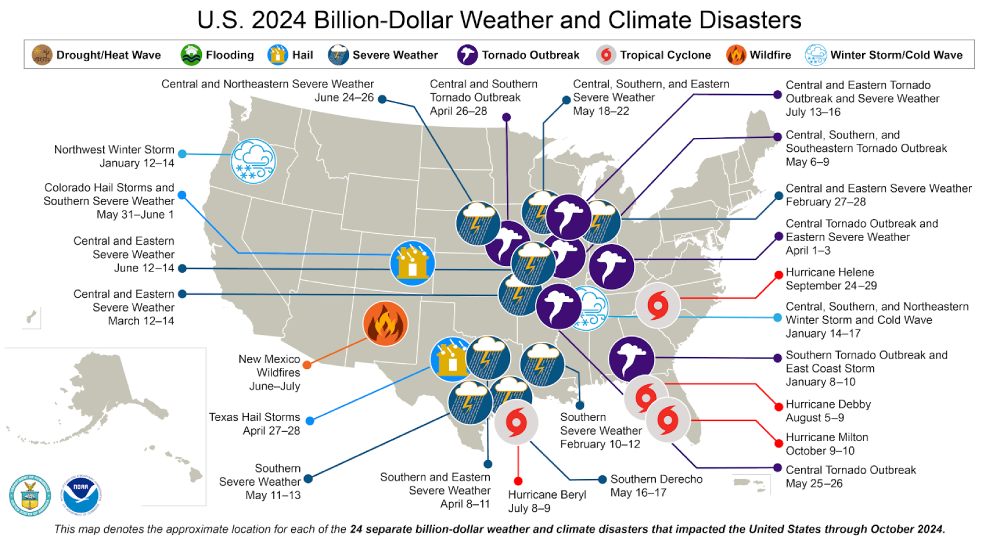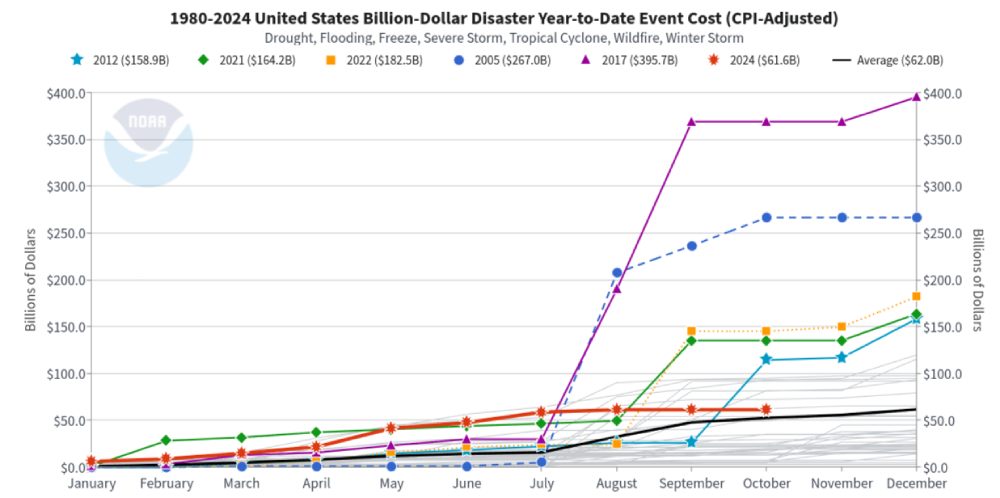The U.S. has sustained 400 weather and climate disasters since 1980 where overall damages/costs reached or exceeded $1 billion (including CPI adjustment to 2024). The total cost of these 400 events exceeds $2.785 trillion.
View summary data in Summary Stats
2024 in Progress…
In 2024 (as of November 1), there have been 24 confirmed weather/climate disaster events with losses exceeding $1 billion each to affect United States. These events included 17 severe storm events, 4 tropical cyclone events, 1 wildfire event, and 2 winter storm events. Overall, these events resulted in the deaths of 418 people and had significant economic effects on the areas impacted. The 1980–2023 annual average is 8.5 events (CPI-adjusted); the annual average for the most recent 5 years (2019–2023) is 20.4 events (CPI-adjusted).

Potential Billion-Dollar Event
The following is a compilation of events in which damage costs potentially exceed the $1 billion-threshold. This is only a preliminary list as calculations are not yet finalized and total costs have not been determined (as of November 1, 2024).

Methodology and Data Sources
The National Centers for Environmental Information (NCEI) is the Nation's Scorekeeper in terms of addressing severe weather and climate events in their historical perspective. As part of its responsibility of monitoring and assessing the climate, NCEI tracks and evaluates climate events in the U.S. and globally that have great economic and societal impacts. NCEI is frequently called upon to provide summaries of global and U.S. temperature and precipitation trends, extremes, and comparisons in their historical perspective.
The Billion-dollar disasters product is intended to show the impact of extreme weather and climate events on the economy in inflation adjusted dollars. We cannot control how others use the product, but we consistently note that disaster impacts are a combination of increased risk and the possible impacts of climate change. For example, the increase in population and material wealth over the last several decades are an important cause for the rising costs. These trends are further complicated by the fact that much of the growth has taken place in vulnerable areas like coasts, the wildland-urban interface, and river floodplains.
Vulnerability is especially high where building codes are insufficient for reducing damage from extreme events. This is part of the reason that the 2010s decade is far costlier than the 2000s, 1990s, or 1980s (all inflation adjusted to current dollars). The methodology and data sets are documented in the peer reviewed literature and on the NCEI website. This product has no focus on climate event attribution.
The number and cost of weather and climate disasters are increasing in the United States due to a combination of increased exposure (i.e., more assets at risk), vulnerability (i.e., how much damage a hazard of given intensity -wind speed, or flood depth, for example - causes at a location), and the fact that climate change is increasing the frequency of some types of extremes that lead to billion-dollar disasters (Fifth U.S. National Climate Assessment (2023)).
We also know from research using other kinds of climate and weather data that climate change can enhance the frequency and intensity of certain types of extreme weather that lead to billion-dollar disasters - most notably the rise in vulnerability to drought, lengthening wildfire seasons in the Western states, and the potential for extremely heavy rainfall becoming more common in the eastern states. Sea level rise can worsen hurricane storm surge flooding (Fifth U.S. National Climate Assessment (2023)).
In 2012, NCEI -- then known as National Climatic Data Center (NCDC) -- reviewed its methodology on how it develops Billion-dollar Disasters. NCEI held a workshop with economic experts (May, 2012) and worked with a consulting partner to examine possible inaccuracy and biases in the data sources and methodology used in developing the loss assessments (mid-2013). This ensures more consistency with the numbers NCEI provides on a yearly basis and give more confidence in the year-to-year comparison of information.
Another outcome is a published peer-reviewed article "U.S. Billion-dollar Weather and Climate Disasters: Data Sources, Trends, Accuracy and Biases" (Smith and Katz, 2013). This research found the net effect of all biases appears to be an underestimation of average loss. In particular, it is shown that the factor approach can result in an underestimation of average loss of approximately 10–15%. This bias was corrected during a reanalysis of the loss data to reflect new loss totals.
It is also known that the uncertainty of loss estimates differ by disaster event type reflecting the quality and completeness of the data sources used in our loss estimation. In 2024, two of the twenty separate billion-dollar events (i.e., Hurricane Beryl and the June-July New Mexico wildfires) have higher potential uncertainty values around the loss estimates due to less coverage of insured assets and data latency. The remaining eighteen events (i.e., the winter storms and severe storm events producing tornado, hail and high wind damage) have lower potential uncertainty surrounding their estimate due to more complete insurance coverage and data availability.
One approach to understanding cost uncertainty is discussed in the peer-reviewed article "Quantifying Uncertainty and Variable Sensitivity within the U.S. Billion-dollar Weather and Climate Disaster Cost Estimates" (Smith and Matthews, 2015). More recent feedback from the American Meteorological Society community have suggested that we incorporate smaller cost thresholds into our analysis, to more completely capture the hazard risk space. We are currently developing this more comprehensive scope, by quantifying the total, direct losses for all sub-billion events down to $100 million, from 1980-present. This will provide new analysis for hundreds of events and more completely describe the weather and climate event frequency and cost distribution over space, time and by hazard.
In performing these disaster cost assessments these statistics were developed using the most comprehensive public and private sector sources and represent the estimated total costs of these events -- that is, the costs in terms of dollars that would not have been incurred had the event not taken place. More than one dozen public and private sector data sources help capture the total, direct costs (both insured and uninsured) of the weather and climate events. These costs include: physical damage to residential, commercial, and municipal buildings; material assets (content) within buildings; time element losses such as business interruption or loss of living quarters; damage to vehicles and boats; public assets including roads, bridges, levees; electrical infrastructure and offshore energy platforms; agricultural assets including crops, livestock, and commercial timber; and wildfire suppression costs, among others.
However, these disaster costs do not take into account losses to: natural capital or environmental degradation; mental or physical healthcare related costs, the value of a statistical life (VSL); or supply chain, contingent business interruption costs. Therefore, our estimates should be considered conservative with respect to what is truly lost, but cannot be completely measured due to a lack of consistently available data. Sources include the National Weather Service, the Federal Emergency Management Agency, U.S. Department of Agriculture, National Interagency Fire Center, U.S. Army Corps, individual state emergency management agencies, state and regional climate centers and insurance industry estimates, among others.
Links to key public sector data sources include FEMA Public Assistance, FEMA Individual Assistance, USDA Risk Management Agency Crop Indemnity, the USDA National Agricultural Statistics Service, the National Interagency Fire Center wildfire data, the National Flood Insurance Program claims data and the NOAA Storm Events Database. We also reference state insurance services such as CalFire and FLOIR, the U.S. Department of Defense disaster impact reports, the Federal Highway Administration damage reports and private property insurance data as part of this event analysis.
We also examine insurance penetration rates for vehicle insurance, home insurance, flood insurance, crop insurance, and business coverage, to better understand insured and uninsured assets. As a point of comparison for robustness, NCEI assessed 28 separate billion-dollar disaster events in 2023. For 12 of these events, the NCEI damage estimates were smaller than those in other sources, such as Gallagher Re, AON, and Munich Re. For the other 16 events, the NCEI estimates fell within the range of the other reports such as Gallagher Re, Munich Re and AON 2023 disaster cost reports. In addition, we incorporate socioeconomic risk information from the Census American Community Surveys, the CDC Social Vulnerability Index, among others that provide additional spatial context of hazard risk.
For more information on risk, here is a presentation: Smith, A., 2022: 2021 U.S. Billion-dollar weather and climate disasters in historical context and new hazard and socioeconomic risk mapping. April 2022, AMS Washington Forum, Washington, DC.April 2022, AMS Washington ForumSmith, A., 2022: 2021 U.S. Billion-dollar weather and climate disasters in historical context and new hazard and socioeconomic risk mapping. April 2022, AMS Washington Forum, Washington, DC.
For more recent analysis, the following report offers the latest summary on the 2023 - A historic year of U.S. billion-dollar weather and climate disasters.
Citing this information:
- NOAA National Centers for Environmental Information (NCEI) U.S. Billion-Dollar Weather and Climate Disasters (2024). https://www.ncei.noaa.gov/access/billions/, DOI: 10.25921/stkw-7w73




